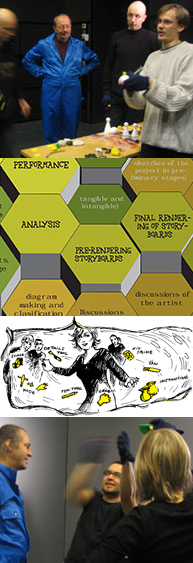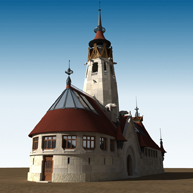|
|
 |
 |
 |
 |
| Research in the Media Lab includes basic research and a significant amount of externally funded research and development in which the broad base of knowledge, as well as the advanced artistic and design skills of the lab's community is applied. Research and development is undertaken in national and international partnerships, in which the Media Lab's role, methods and output can be understood as a working strategy for innovation as well as the critical development of research per se within a new and complex field. |
|
 |
| Development of Knowledge About User Experience |
 |
|
 |
This includes Task Analysis of modeling, a Domain Analysis for the field of 3D graphics,
and User Studies with our partners working with 3D graphic tools. In making the task analysis we create and analyze a teapot,
an object that has a long legacy in the world of 3D graphics, with three Open Source applications. As the basis of our work, we have selected a teapot from the collection of Arabia, a Finnish ceramics company. The teapot is not in production anymore, so, by creating a digital replica we are able to preserve the object and it becomes digital cultural heritage.
The purpose of the domain analysis is to help reveal the conceptual problems of the field of computer-aided 3D design and
thereby enable the design of better human-computer interfaces. Starting from review of the field the domain analysis proceeds
into describing methods of interaction, user interface concepts and available elements for building models in existing Open Source 3D applications.
It also presents profiles of typical users of these programs.
In the scope of this project we also make user studies in the partner companies with the aim of finding out about current use contexts of
3D applications and future design opportunities. |
|
 |
| |
 |
| Development of New Concepts and Metaphors for User Interface Design |
 |
 |
For this task we planned and conducted an interdisciplinary workshop on collaborative scenario development. The workshop focused on bringing together the diverse cultures of knowledge in the project, namely science and art and design with the objective of developing new user interface concepts and metaphors.
Scenarios can provide developers the opportunity to envision the many consequences entailed in a system design before it is actually produced physically. In HandsOn, we have developed a method that makes use of role-playing and body storming to involve all participants in the collaborative creation of design scenarios. Two scenarios have been created: one describing the user experience for a gesture-based user interface and the other detailing the workings of a tangible user interface system for 3D modeling and animation.
The scenarios have been used to represent interaction and system components with diverse kinds and amounts of detailing. As "boundary objects", they assisted in bridging temporal, conceptual, and linguistic distances and barriers among team members. But more important, the scenarios created operate as a type of generative score allowing for subsequent iterative development and with multiple layers of representation to capture the interaction and design proposals produced by the project's participants.
The method that was developed for the workshop was further applied and tested as part of the MA teaching activities in the Procedural Narrative workshop held in Media Lab in the autumn of 2007. |
|
| |
 |
| Concepting and User Testing of Prototypes |
 |
 |
Our case study proposes to make use of the immersive 3D digital interface that is being created in the HandsOn project to showcase a digital replica of the Finnish Pavilion of 1900. The case study, that is being developed in collaboration with EVTEK, will be used to test as well as showcase the interface and tools developed by TKK and TTY. |
|
| |
 |
 |
|
